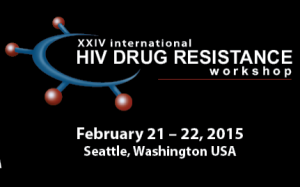Higher rates of K65R in non-B subtype in large UK cohort and implications of tenofovir resistance in resource-limited settings
24 March 2015. Related: Conference reports, Drug resistance, Intl Drug Resistance Workshop 24 Seattle 2015.
 Simon Collins, HIV i-Base
Simon Collins, HIV i-Base
Given the cost pressures on universal access to HIV medicines in resource-limited settings, it is a considerable achievement that global use of tenofovir has largely – and rightly – replaced use of d4T which was initially much cheaper but also associated with more serious toxicity.
There is a caution that some subtypes, notably subtype C, might be more susceptible to the key K65R tenofovir-associated mutation (due to differences in the template at RT 64-66), especially in the context of use in settings without routine viral load monitoring. Several groups reported on this at the meeting.
Data from the UK HIV Drug Resistance Database reported higher rates of K65R with subtype C compared to subtype B. The analysis included samples from 4,242 patients on failing treatment, collected from 1996-2013, irrespective of drugs used or treatment combination. Of these 3,439 were subtype B (77% MSM) and 803 subtype C (82% heterosexual). [1]
Prevalence of K65R was related to subtype and exposure to the NRTIs that select for this mutation (tenofovir, abacavir, ddI and d4T). Overall, K65R was detected in 7.8% subtype B patients after a median 5.0 years (IQR: 1.6-7.8) from initiating ART, compared with 14.5% in patients with subtype C at a median of 2.5 years (IQR: 0.8-5.1) after starting ART.
The subtype difference in K65R prevalence was observed irrespective of NRTI exposure. K65R was frequently seen in patients with no previous exposure to tenofovir. Although prevalence of thymidine analogue mutations was similar, K65R was significantly more common in subtype C (OR 1.95: 95% CI: 1.51 to 2.51, p<0.001).
Although associations can not show causation, this study is important ofr its size, together with the significant differences observed in the prevalence of K65R and time to develop resistance.
In a study from Kenya, the prevalence of K65R was reported from a cohort of 332 people who had been on tenofovir plus NNRTI-based ART for >6 months. Of these, 216 were treatment-naive when starting tenofovir and 116 had switched to tenofovir when already on treatment. [2]
Overall, viral load was detectable in 17% of patients and in 10% of patients it was >1000 copies/mL. However, viral failure was 23% in the previously naive patients (after a median 20 months on ART) compared to 7% in those who switched (after a median 24 months on TDF and 47 months on prior ART). This difference was significant (p<0.001).
Genotype results were available for 35 patients showed that high levels of NNRTI (89%), RT (89%), dual class (83%) and RT K69R (69%). HIV subtype (69% A, 12% C, 11% D, 9% A/D) was not statistically significant (p=0.22) and RT region 64-66 were similar to subtype B indicated this was not due to higher subtype susceptibility in this cohort. Higher failure rates were associated with tradition reasons for virologic failure, including lower CD4 count (p=0.02), higher WHO stage (p=0.004) and higher RT resistance (p<0.001).
In this case, the results are important for showing that switching to tenofovir was not associated with higher risk of treatment failure due to drug resistance.
A study from South Africa looked at the prevalence of K65R in 86 patients with treatment failure using a tenofovir-including combination. The group also looked at low frequency K65R variants using deep sequencing with a 1% threshold. [3]
Using Sanger sequencing, 79/86 samples were amplified and 47/79 (60%) had K65R. Deep sequencing identified K65R in a further 8/27 samples (5 were not available) at frequencies ranging from 1% – 32%. Taking the results together the researchers concluded a conservative prevalence of 70%. Deep sequencing in these 27 patients also identified high rates of NNRTI mutations that were missed by Sanger, changing the interpretation of drug sensitivity in 16/27 (60%) cases.
An analysis of 101 treatment-experienced patients in Cameroon with first-line combinations of d4T with or without AZT in various NNRTI-based combinations concluded that the complexity of cross-resistance of thymidine analogue mutations required genotypic resistance testing to be able to select fully active NRTIs for second-line therapy.
Unfortunately, much of the rest of the workshop emphasised how far away this need was from reality.
Comment
The K65R findings in the UK supports the by easier selection of drug resistanc in subtype C due to the differences in codon utilisation at positions 64 65 and 66.
As cohort data, it would be important in the UK setting to know whether different care received by Africans compared to gay men in the UK might contributes to different patterns of adherence and so development of resistance?
Outside the UK, it highlights the importance of similar studies being run in countries with predominantly subtype C epidemics as tenofovir is now more widely used as standard of care.
References:
Unless stated otherwise, references are to the Programme and Abstracts of the XXIV International HIV Drug Resistance Workshop, 21-22 February 2015, Seattle, Washington.
- Smit E et al. K65R detected more frequently in HIV-1 subtype C viruses at virological failure. Abstract 89.
- Brooks K et al. Viral failure and high K65R in Kenyan patients on tenofovir-based 1st-line therapy. Poster abstract 5.
- Casadellà M et al. Limited treatment options after virological failure of first-line tenofovir-based regimens in South Africa. Abstract 39.
- Fokam J et al. Usefulness of HIV-1 resistance testing in switching patients from first- to second-line antiretroviral regimens in resource-limited settings. Abstract 17.

